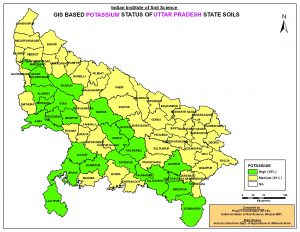Six well defined and distinct soil groups differing from one another in their geological formation and pedogenic

characters have been recognized. These are Bhabar soils, Tarai soils, Vindhyan soils, Bundelkhand soils, Aravali soils and Alluvial soils. Each of these soil groups have developed under the combined influence of a wide range of soil forming factors including climate, vegetation and parent materials. The major coverage of alluvial soil in further grouped as saline alkaline- soils, Karail soils and Bhatt soils.
Soils in most of the districts of Uttar Pradesh are low in available Nitrogen, forty one districts have low in available
Phosphorus status and fourteen districts are medium in available Phosphorus (Bareilly, Moradabad, Bijnor, Farukabad, Faizabad, Bahraich, Gond, Hardoi, Lakhimpur and Sitapur). Available Potassium is low in twenty nine districts. Seventeen percent soils are medium in available Potassium status, and four percent soils high Potassium.
Soils of recent alluvium, Ganga plains and uplands, central lowlands, Yamuna uplands and Kanpur districts are rated medium to high in available Sulphur.
The available Zinc status in Basti, Deoria, Azamgarh, Ballia, Ghazipur and Jaunpur are low. However, the soils in Ghazipur, Jaunpur, Varanasi, Deoria and Gorakhpur districts rated high in Zinc status. Soils of Bulandshar, Meerut, Muzaffarpur, Hamirpur and Banda districts are highly deficient in available Zinc.
Availability of Iron in the soils varied in the following order Hill > Alluvial >Vindhyan > Bundelkhand >Tarai. Soils of Unnao, Hardoi, and Farukhabad are low in available Iron status.
UPPCS Notes brings Prelims and Mains programs for UPPCS Prelims and UPPCS Mains Exam preparation. Various Programs initiated by UPPCS Notes are as follows:-- UPPCS Mains Tests and Notes Program
- UPPCS Prelims Exam 2024- Test Series and Notes Program
- UPPCS Prelims and Mains Tests Series and Notes Program
- UPPCS Detailed Complete Prelims Notes